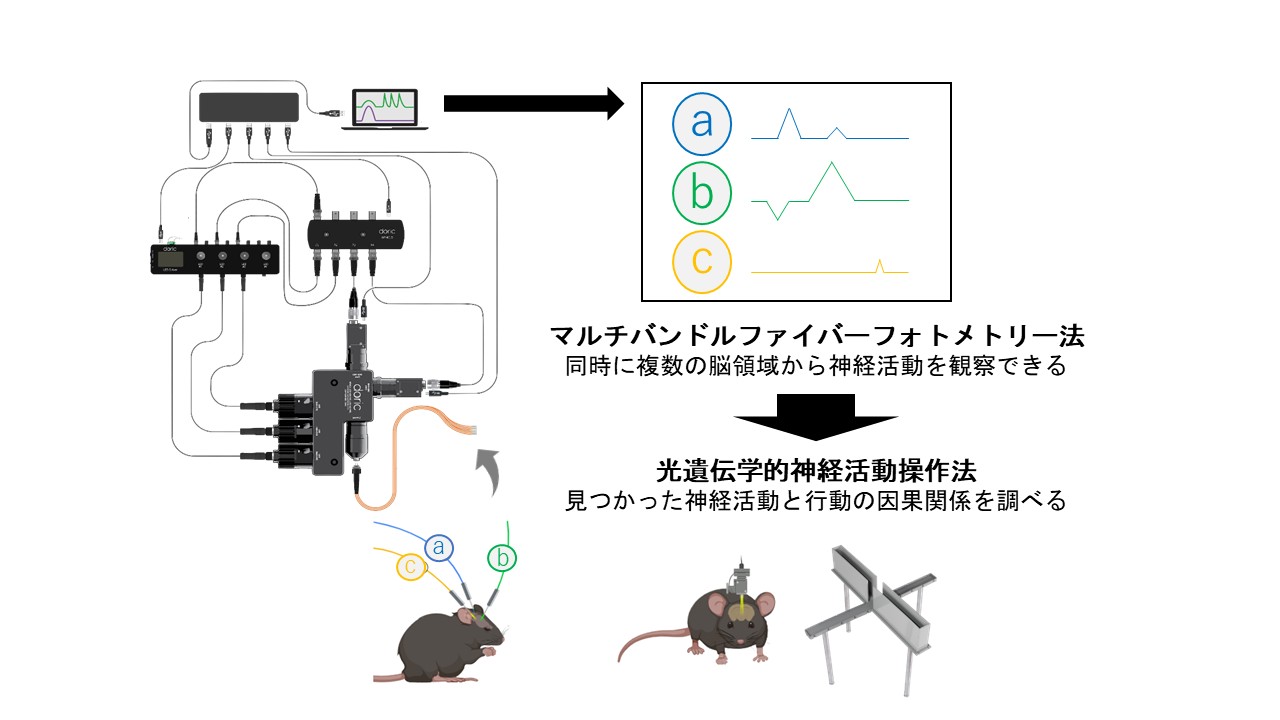学習・意思決定の神経機構Neural mechanisms of learning and decision-making
私達の日常は学習と意思決定の連続で成り立っています。環境から情報を受容し、意思決定・行動選択し、その結果を評価することで最適解を導くよう学習します。多くの精神・神経疾患でこの生命活動の基礎となる学習・意思決定機構が障害を受け、日常生活や社会生活に困難をきたします。木村グループでは、学習・意思決定の神経メカニズムを解き明かし、種々の疾患における学習・意思決定障害の病態解明や、その治療法開発を目指して研究を行っています。
Our daily life consists of chains of learning/decision-making processes. Animals learn to modulate their decision/strategy to choose the best option when receiving external/internal information. In patients with various mental/neurological disorders, such learning and decision-making processes are impaired which disrupts their daily and social lives. Tsutsui-Kimura group has been studying to understand the neural mechanisms of learning and decision-making which would contribute to revealing the pathophysiological mechanisms of cognitive deficits in the mental/neurological disorders and developing a new therapeutic method.

報酬獲得と恐怖・嫌悪回避を司る神経基盤Neural basis for approach vs. avoidance conflict
神経科学において、報酬と恐怖・嫌悪に関する研究はしばしば独立に取り扱われてきました。しかし、実社会では、報酬と恐怖・嫌悪が同時に想起され、報酬獲得と恐怖・嫌悪回避のどちらを選択するかを迫られる場面の方が多く、脳が葛藤をどのように解くのか、そのメカニズムを知ることは重要です。木村グループでは、報酬獲得学習と嫌悪回避学習が、ドーパミン神経系を中心に神経分子・回路的に非常に類似した構造で成立する可能性を見出していることから、マウスを用いて葛藤の神経基盤を解き明かす研究を行っています。
In the field of neuroscience, rewarding and threatening/aversive systems have often been studied independently. However, in our daily life, it is more natural to expect both events simultaneously and we have to choose better options in accordance with the ongoing context. Tsutsui-Kimura group has been interested in how the brain solves these conflicting situations. Based on the recent discovery that approaching reward and avoiding threat/aversion can be processed with similar dopamine-based architecture, we study to reveal the neural basis of approach/avoidance conflict.
関連文献
I. Tsutsui-Kimura, ZM. Tian, R. Amo, Y. Zhuo, Y. Li, MG. Campbell, N. Uchida, M. Watabe-Uchida, Dopamine in the tail of the striatum facilitates avoidance in threat-reward conflict, Nat Neurosci, 2025, 28(4), 795-810.
K. Akiti, I. Tsutsui-Kimura, Y. Xie, A. Mathis, JE. Markowitz, R. Anyoha, SR. Datta, MW. Mathis, N. Uchida, M. Watabe-Uchida, Striatal dopamine explains novelty-induced behavioral dynamics and individual variability in threat prediction, Neuron, 2022, 110, 3789-3804.
I. Tsutsui-Kimura, Y. Bouchekioua, M. Mimura, KF. Tanaka, A new paradigm for evaluating avoidance/escape motivation, Int J Neuropsychopharmacol, 2017, 20, 593-601.
柔軟性と効率性を司る神経基盤Neural basis for flexible and automated behavior
新しい環境において、試行錯誤や柔軟な思考は報酬を得るための最適解を導き出すために重要です。一方、馴染みの環境では、思考を挟まず行動をルーティン化した方が効率よく報酬を得られます。このような柔軟性と効率性の切り替えを脳はどのように行っているのでしょうか?私たちのグループではマウスを用いて、ドーパミン神経と大脳基底核経路に着目して、その神経機構を明らかにする研究を行っています。
Try-and-error based flexible choice is essential for maximizing the future reward in a new environment while automated actions is efficient to obtain reward in the familiar environment. How does brain switch between flexibility and automaticity depending on the current context? Tsutsui-Kimura group has been examining the brain mechanisms underlying flexible and automated behaviors by shedding light on the dopamine-basal ganglia circuits.
関連文献
A. Kono, Y. Shikano, KF. Tanaka, K, Yamaura, I. Tsutsui-Kimura, Inhibition of the dorsomedial striatal direct pathway is essential for the execution of action sequences, Neuropsychopharmacol Rep, 2023, 43, 414-424.
I. Tsutsui-Kimura, H. Matsumoto, K. Akiti, MM. Yamada, N. Uchida, M. Watabe-Uchida, Distinct temporal difference error signals in dopamine axons in three regions of the striatum in a decision-making task, eLife, 2020, 9: e62390.
I. Tsutsui-Kimura, A. Natsubori, M. Mori, K. Kobayashi, MR. Drew, A. de Kerchove d'Exaerde, M. Mimura, KF. Tanaka, Distinct roles of ventromedial versus ventrolateral striatal medium spiny neurons in reward-oriented behavior, Curr Biol, 2017, 27, 3042-3048.
I. Tsutsui-Kimura, H. Takiue, K. Yoshida, M. Xu, R. Yano, H. Ohta, H. Nishida, Y. Bouchekioua, H. Okano, M. Uchigashima, M. Watanabe, N. Takata, MR. Drew, H. Sano, M. Mimura, KF. Tanaka, Dysfunction of ventrolateral striatal dopamine receptor type 2-expressing medium spiny neurons impairs instrumental motivation, Nat Commun, 2017, 8, 14304.

